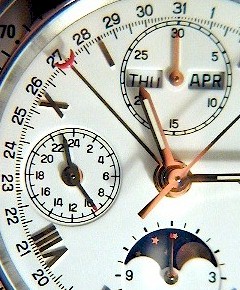|
||
| THE STORY | THE PROJECT | FUNCTIONS |
|
||
| THE STORY | THE PROJECT | FUNCTIONS |
| COMPLICATIONS! Eight hands and three discs total make the following functions possible:
|
 Applied roman numeral markers and all 8 hands plated in gold? |
|
24-HR HAND AND SUBSIDIARY
SECONDS Located at 9 o'clock, this is the only moving second hand when the chronograph mechanism is not engaged. The 24hr hand plays a very important role when setting the watch (more on setting the watch further down). As I later point out, it is not advisable to set some calendar functions during times when the gears and mechanisms are engaged in critical transitory calendar phases, but I will describe that below. Another advantage of the 24hr hand is that it makes it impossible to the time wrong (i.e., set for noon at midnight or voice versa). |
| DAY OF THE WEEK, MONTH &
JUMPING CHRONOGRAPH MINUTE REGISTER HAND Located at the 12 o'clock position, within the chronograph minute-register sub-dial, are two small windows on the dial that reveal the Day of the Week and the Month in progress. Also on this dial is the "jumping" minute register. It's fun to watch this hand "jump" as the central chronograph hand does one revolution. Again, the tip of this hand has been colored red for legibility and aesthetics. |
|
|
MOON PHASE INDICATOR AND
CHRONOGRAPH HOUR REGISTER This is what sets my Omega Speedmaster apart from the current production models....Located at the 6 o'clock position, this subsidiary dial has a window through which the current moon phase can be viewed. (Read about the accuracy of this indicator at the bottom of the page) Also located in this subsidiary dial is the chronograph hour register hand. It is very useful after 30 minutes into the operation of the chronograph, since it is only here that you see how long it has been since the chronograph function was engaged. It can register up to 12 hours after which it repeats its cycle. |
| THE FULL CALENDAR: IN ACTION For me, what makes this watch so great are it's many complications, of which the "Full Calendar" is certainly one. Granted this is not a "Perpetual Calendar" where one does not have to adjust months with 28,29 or 30 days, but instead this calendar operates much like classic calendar plates. In any event, I find it an entertaining moment to watch these transitions at the end of the day. Although the changes begin to occur around 9 PM, they only become obvious after 11:00pm when the Date hand, of which I colored its tip red like classic watches, begins its gradual transition. Soon after, the Day disc begins turning gradually as well. As you can see from the illustration on the right, one can see the system is in transition. At midnight, the Date hand finally "drops" into the position, while the Day disc takes an additional 5 minutes to finish its voyage. |
 Here you can clearly see the transitory phase in progress, from Thursday April 27 into Friday April 28, complete with moon phases. Also, note that I have painted the tip of the date hand red, to honor the tradition. |
The
Valjoux 7751/modified Omega 1151 All of the action is located on this beautifully finished calendar plate. Which is where the Valjoux 7751 (Omega 1151) and 7750 (Omega 1152) differ. It would be important to note that not all Valjoux 7751s are finished like this, since Omega has additional functional and aesthetic finishing (although they do not have exhibition backs) and some of the parts are unique on its movements. It would also be important to mention that the current line of Day-Date Speedmasters (caliber 1151) do not have the moon phase drive mechanism, nor its many components in place. The Omega movement corresponding to the Speedmaster Classic of the early 1990s was the Omega 1150, which is a 17 jewel version of the Valjoux 7751 with guild-finish. |
|
|
The timekeeping mechanism drives the Calendar wheel
that drives the Day disc and Moon phase
Yoke and engages with the Date
wheel that once per month engages (via the Month
Finger) with the Month wheel
that drives the Month disc. The Month finger is on a disc attached on top of the date wheel. After the 31 day cycle, it engages with the Month wheel which transitions the Month disc to the next month in pretty much the same manner that the Day disc operates. It is important to note that both the Day and Month discs are held in place with jumpers (not in view) that look like the Moon phase Jumper. |
In order to better follow the description, I suggest reviewing the large picture above with all the parts' labels. |
MOON PHASE DRIVE MECHANISM The Moon phase Yoke, which is held in place by two springs, is activated by the revolving of the odd-shaped perimeter of the Calendar wheel. The Moon phase Corrector and the three Jumpers for each of the three discs (Day, Month, Moon) also have similar springs which hold them in place. When the calendar wheel moves into a certain position, the shape of the calendar wheel's perimeter pushes the Moon phase Yoke which moves with "See-Saw" action, driving its other end into one of the teeth of the Moon phase Disc. This simple action, which takes place apparently from 3 am to 4 am, perfectly advances the Moon phase Disc one tooth (1/59th of a full cycle). |
| ADJUSTING THE CALENDAR Adjusting the calendar is somewhat of a pleasure as well, since it is not complicated and it can be done very quickly via the crown and one single case button located at 10 o'clock. Of course one must take special caution when it comes to making any type of date adjustment during the time that the calendar is in transition to avoid the possibility of jamming or damaging the movement. This is one of the occasions in which the 24 hr hand comes in handy. The crown has three positions. In the "in" position the chronograph is water resistant, and can be manually wound. In position two, the crown acts as a date and month corrector as well as moon phase corrector. And, in position three, the time can be set. In this position, the seconds stop as well so that the timepiece may be synchronized with an official time signal. |
A difficult to photograph play of lights is the result of a combination of both polished and brushed surfaces on the sides of the watch, much like on its sibling, the Omega Speedmaster Professional. I think that the octagonal winding-crown, the large polished bezel, and the "president-style" bracelet, give this otherwise sporty case a touch of class. |
In order to better follow the descriptions, you may want to "review" the large, labeled picture labeled "THE CALENDAR MECHANISM". |
HOW CALENDAR CORRECTION WORKS In order to make adjustments to the Date, Month and/or Moon phase, one must pull the crown out to position two. In this position, the Date/Moon phase Corrector Star takes center stage. Its clever design allows for a rocking motion depending on the direction the crown is turned. Thus, if the crown is rotated clockwise, the Moon phase Corrector Star moves down, and engages with the Moon phase Corrector itself, pushing it down with each turn of the star, causing the Moon phase Jumper, that holds the Moon phase disc in place with light pressure, to retrieve allowing the corrector to advance the Moon phase disc one tooth at a time. If the crown is turned counterclockwise the Date/Moon phase corrector moves left to engage with the Date wheel, efficiently advancing it. Since the Date Wheel drives the Month Wheel (once every 31 day cycle) via the Month Finger, there is no need for additional devices to adjust the month, as it happens automatically. The Day of the week can be easily adjusted by pressing the recessed case-band button located at 10 o'clock. One single push of the button and the Day advances instantly. |
| HOW ACCURATE IS THE MOON PHASE
INDICATOR? Based on the data that the real moon phase
is 29 days 12 hrs 44 minutes and 3 seconds, and that this watch, like most moon phase
discs, has 59 teeth advancing at the rate of 1 tooth per day (reflecting two 29.5 day moon
cycles on the disc), the indicator would be fast by 88.1 minutes every 59 day revolution. How often does it need to be corrected? It would have to be corrected every 2 years, 33 weeks, 3
days, 36 minutes, and 30.23911584 seconds. |
The Current Moon phase |
Pictures of the watch
not to be used without my explicit permission.
No affiliation whatsoever to Omega Watch Company or any other company
mentioned herein.
Not for commercial purposes. Copyright 2000.